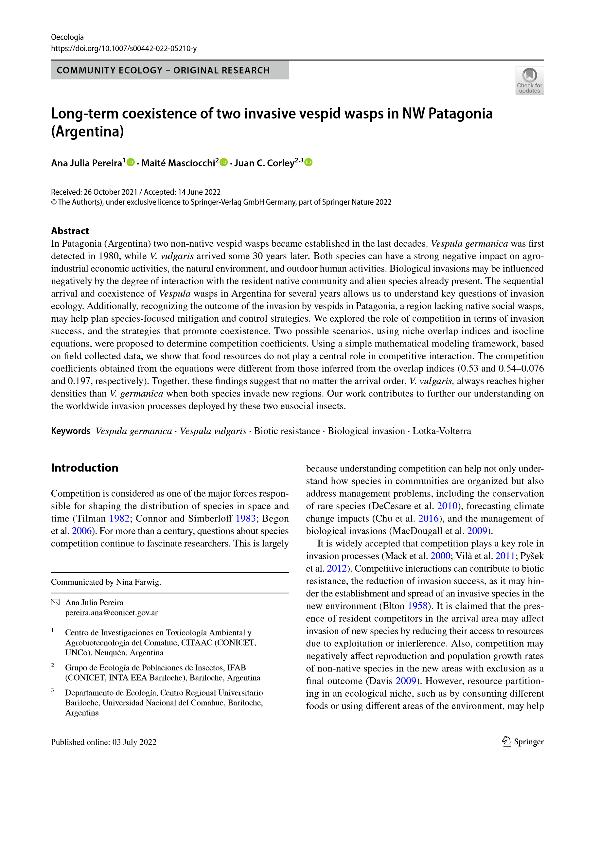Artículo
Long‑term coexistence of two invasive vespid wasps in NW Patagonia (Argentina)
Fecha de publicación:
06/2022
Editorial:
Springer
Revista:
Oecologia
ISSN:
0029-8549
Idioma:
Inglés
Tipo de recurso:
Artículo publicado
Clasificación temática:
Resumen
In Patagonia (Argentina) two non-native vespid wasps became established in the last decades. Vespula germanica was first detected in 1980, while V. vulgaris arrived some 30 years later. Both species can have a strong negative impact on agro-industrial economic activities, the natural environment, and outdoor human activities. Biological invasions may be influenced negatively by the degree of interaction with the resident native community and alien species already present. The sequential arrival and coexistence of Vespula wasps in Argentina for several years allows us to understand key questions of invasion ecology. Additionally, recognizing the outcome of the invasion by vespids in Patagonia, a region lacking native social wasps, may help plan species-focused mitigation and control strategies. We explored the role of competition in terms of invasion success, and the strategies that promote coexistence. Two possible scenarios, using niche overlap indices and isocline equations, were proposed to determine competition coefficients. Using a simple mathematical modeling framework, based on field collected data, we show that food resources do not play a central role in competitive interaction. The competition coefficients obtained from the equations were different from those inferred from the overlap indices (0.53 and 0.54–0.076 and 0.197, respectively). Together, these findings suggest that no matter the arrival order, V. vulgaris, always reaches higher densities than V. germanica when both species invade new regions. Our work contributes to further our understanding on the worldwide invasion processes deployed by these two eusocial insects.
Archivos asociados
Licencia
Identificadores
Colecciones
Articulos (IFAB)
Articulos de INSTITUTO DE INVESTIGACIONES FORESTALES Y AGROPECUARIAS BARILOCHE
Articulos de INSTITUTO DE INVESTIGACIONES FORESTALES Y AGROPECUARIAS BARILOCHE
Articulos(CITAAC)
Articulos de CENTRO DE INVESTIGACIONES EN TOXICOLOGIA AMBIENTAL Y AGROBIOTECNOLOGIA DEL COMAHUE
Articulos de CENTRO DE INVESTIGACIONES EN TOXICOLOGIA AMBIENTAL Y AGROBIOTECNOLOGIA DEL COMAHUE
Citación
Pereira, Ana Julia; Masciocchi, Maité; Corley, Juan Carlos; Long‑term coexistence of two invasive vespid wasps in NW Patagonia (Argentina); Springer; Oecologia; 199; 3; 6-2022; 661-669
Compartir
Altmétricas




